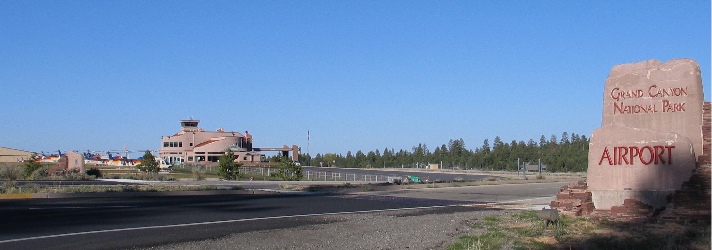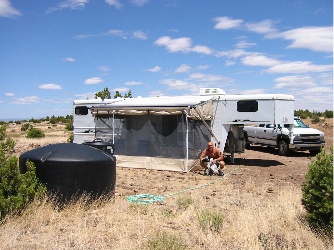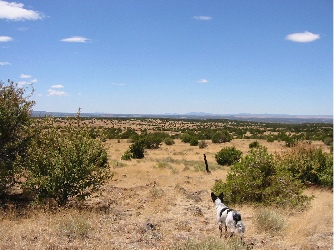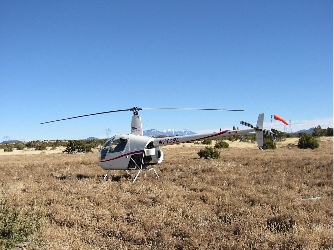I make a visit to the FAA tower without any loss of life.
Grand Canyon Airport has two control towers. (Well, three, if you count the vacant one.)
One is at Papillon’s heliport. Attached to the building and accessible by its own staircase, it rises four stories above the heliport. It’s a small, simple room with enough space for two “controllers” and two or three visitors. New pilots are encouraged to visit the tower, to get a good idea of how traffic is controlled by Papillon’s tower staff. It’s amazing, really. Not only do the tower folks keep track of all us pilots as we’re flying in and out of the airport, but they manage aircraft loading, arrange flight (and break) schedules, and open and close flight plans with Prescott Flight Service Station. It’s safe to say that Papillon’s tower is the nerve center for the whole operation.
The other tower is the big, FAA tower. It’s an impressive structure, brand new and very tall. I’ve seen lot of control towers, both as a pilot and as a passenger on an airline, and this tower ranks high in the tower hierarchy. It’s at least as big as the one in Phoenix and possibly as tall, a slim white structure with a glassed-in octagon on top.
(The old, vacant tower is one of those four-story structures that were built on many Class Delta airports. Chandler has one just like it. I’ve been in Chandler’s tower and it wasn’t much more impressive than Papillon’s. Grand Canyon Tower’s staff moved out of that building to the new one a few years ago. Now they look at it across the runway and remember the roaches that infested it.)
I’d been wanting to visit the “big tower” — as I call it — for a while. Since starting at Papillon a month ago, I’ve spent at least three hours in Papillon’s tower. I go up there when I’m not schedule to fly so I can watch the wind readings and listen to the other pilots coming and going. But the big tower was different. It was the official air traffic control center for the airport, the final word, authorized by the FAA. And it was so impressive looking from the outside. What was it like inside?
Today, I finished flying early. Most of us did, in fact — the afternoon was pretty dead. Although Papillon doesn’t like to let pilots go home early, I figured I’d ask if I could visit the big tower. After all, I could be back in minutes; all it took was a call. Permission granted from Papillon’s powers-that-be, I called the big tower to see if I could visit.
After 9/11, tower security is generally very tight. In fact, I seriously doubt whether just anyone could get in. But I introduced myself by name and told them I was a Papillon pilot. I asked if I could visit, but only if they weren’t too busy. Gary, the guy on duty, put me on hold, then came back and said yes. “Drive up to the gate and we’ll buzz you in,” he advised me.
I was out in the Jeep in a flash, zipping out of Papillon’s parking lot and driving past the terminal building. I went straight where signs advised that “All Traffic Must Turn Left” and passed a sign that said “FAA Control Tower. Authorized Vehicles Only.” Gary had authorized me. The road turned to gravel and I continued along it. Then, through the trees, I could see the tower before me, looming up out of the forest. I noticed for the first time that a low building was attached to it. And the whole thing was surrounded by a very serious looking fence with a electric gate.
A sign on the fence said something like “FAA Control Tower. Accidents or loss of life can result from loss of operations.” Something like that. I can’t remember exactly, but I do remember the phrase “loss of life.” I started wondering if my visit could distract the controllers enough to result in loss of life. I hoped not.
There were three boxes on the driver’s side of the entryway before the gate. One was a mystery box; I have no clue what it was for. Another had a camera that looked right at me, kind of like the robot in Short Circuit. The other was a speaking box with a button on it. I pushed the button and waited. Nothing happened.
I started thinking about making radio calls to the tower that weren’t answered. You know, “Copter 28 would like a Southwest departure with Zulu” followed by a lot of silence. The tower just not noticing your call. You hesitating to repeat it, not wanting to piss off the controller, who had probably heard you but was chewing his lunch or swallowing a mouthful of coffee.
I hesitated, then began to wonder whether the button was more like a mike button. I pushed it again and said, “Hello?”
The gate began to open. I waited until it was open enough for my Jeep to squeeze through, then drove through. I waited on the other side. That’s something you’re supposed to do at those kinds of gates. So that other cars didn’t piggyback in with you. It didn’t matter that I’d just driven a half mile down a dirt road and there was no one behind me. The controller could be watching from up above. And then, the next time I needed a clearance, he’d make me wait, even if he wasn’t having lunch or coffee.
I moved on when the gate closed. I noticed that there was a similar arrangement of boxes at the exit gate and wondered whether that was so that they could lock people in. I reminded myself to be on my best behavior as I drove up the concrete drive to the base of the tower.
The parking lot was paved in concrete and had at least ten parking spots. There was one car there. I parked next to it and got out.
I passed a bicycle leaning up against the side of the building as I walked to the front door. I guess you don’t have to worry about getting your bike stolen when you have a security fence with barbed wire and cameras around your place of business.
At the door was another voice box. I tried the door and found it locked. Then I pushed the button on the voice box. Nothing happened. I wondered again whether the button was a mike button, but before I could try my greeting, the door opened from the inside. Danni, one of the controllers, was there to greet me.
I’d met Danni at breakfast one morning about three weeks before. I’d gotten to Tusayan a half hour early and decided to check out the local Internet café to see if they had a wireless network I could tap into. (They didn’t.) As I ordered my latte, I noticed Marty, who’d been one of my flight instructors in Long Beach, sitting at a table with a woman. Marty had taken a job with Papillon the previous year and had come back for the season. Danni was his friend from the tower.
Danni is a really nice person. The first time she hears your voice on the radio in the morning, she says, “Good morning!” and expects a suitable response. And the last flight of the day will always get a “Have a good night!” Not very FAAish, but very nice. Kind of reminds me that we’re all in it together. We’re tourist babysitters. She helps us with our tourists while dealing with the occasionally Sunday pilot’s adventure of landing at GCN.
Danni gave me a tour of the low building. Lot of office space, a full kitchen, and equipment rooms. Everything brand spanking new and totally underutilized. We rode the elevator up to a floor marked 6 (the elevator can stop at 1, 2, and 6; there are no other numbers), then took a flight of stairs to the top level.
Ever wonder why you can’t take an elevator to the top floor in a control tower? It’s because the elevator shaft would block the view. A control tower is a big open room with windows on all sides. And this one had the best view of the Grand Canyon airport area. You could see for miles in every direction.
The room was surrounded with counter space. There were at least ten chairs, but only one had an occupant. Gary sat in the corner, in front of a laptop. A telephone receiver lay on the counter beside him. It turns out that the telephone receiver was actually a microphone, with a push to talk button between the earpiece and mouthpiece. It was on a very long curly cord, and as we chatted, he carried it around with him, talking into it now and then with his ATC voice.
Danni showed me around. I saw the radar screen, which tends to pick up ghost echoes and isn’t certified for use, but showed several aircraft in the area. I saw the wind reporting screen, which showed different winds for each of the three wind measuring locations on the airport, along with an average wind. The average was necessary because all three readings were different. I saw all kinds of screens that we didn’t really talk much about. I saw a device that printed out strips of paper with NOTAM and flight plan information on them. Danni showed me one for an incoming pilot’s flight plan. We looked at the time the pilot was expected in and realized he was due soon. He called in, got clearance, and landed during my visit.
My technical visit turned into a social call before I could stop it. Gary grew up in Wickenburg and wanted to know if I knew the people he’d grown up with. I didn’t. I’ve only been in Wickenburg since 1997; he left town in the early 80s. But that didn’t stop him from naming everyone he knew and making me come up with names of people I knew. Before long, my planned 15-minute visit to the tower had turned into 30 minutes. I told them I had to go.
Danni escorted me downstairs and outside. She told me to visit again. I promised I would.

 This year I had enough time to apply for a job. I sent in a resume and got an interview. Three men interviewed me on March 26. I was nervous at first, but warmed up quickly. It was like the old days of job interviews, but now, nineteen years later, I had the answers. I wasn’t some green kid who didn’t know which way was up. I was an experienced and successful business woman who wanted to explore a new world. When they asked me what I could see myself doing in ten years, I laughed. I said I wasn’t sure about ten, but in fifteen, I’d like to be flying tours in a nice place, like Hawaii. Semi-retirement, you know. I’m a bit older than the kids they’d been hiring.
This year I had enough time to apply for a job. I sent in a resume and got an interview. Three men interviewed me on March 26. I was nervous at first, but warmed up quickly. It was like the old days of job interviews, but now, nineteen years later, I had the answers. I wasn’t some green kid who didn’t know which way was up. I was an experienced and successful business woman who wanted to explore a new world. When they asked me what I could see myself doing in ten years, I laughed. I said I wasn’t sure about ten, but in fifteen, I’d like to be flying tours in a nice place, like Hawaii. Semi-retirement, you know. I’m a bit older than the kids they’d been hiring. I’d earned my epaulets.
I’d earned my epaulets.
 Let me take a moment to describe this trailer. It’s a horse trailer with living quarters. For those of you who don’t know much about the kinds of things horsey people know, imagine a very long (about 35-feet), gooseneck trailer (the kind you have to pull with a pickup), with a travel area in back for horses and a living area up front for people. Our trailer is a pretty nice one, as these things go. It has space in back for three horses and a separate tack closet (where you store the saddles, bridles, etc.). Its tiny bathroom has a shower, toilet, sink, and closet. The fridge is remarkably large (for a trailer) and the freezer can get cold enough to make ice. There’s a two-burner stove, a tiny kitchen sink, some counter space, and a lot of cabinets. There’s also a sofa that converts to a 1-person-under-5’8″-tall bed and a big, queen sized bed over the gooseneck. There’s a microwave and an air conditioner, but a powerful (and noisy) generator (which we don’t have) is required to make them work. I use the microwave to store bread and crackers and the air conditioner as a place to bash my head once a week (on average) when I climb out of bed.
Let me take a moment to describe this trailer. It’s a horse trailer with living quarters. For those of you who don’t know much about the kinds of things horsey people know, imagine a very long (about 35-feet), gooseneck trailer (the kind you have to pull with a pickup), with a travel area in back for horses and a living area up front for people. Our trailer is a pretty nice one, as these things go. It has space in back for three horses and a separate tack closet (where you store the saddles, bridles, etc.). Its tiny bathroom has a shower, toilet, sink, and closet. The fridge is remarkably large (for a trailer) and the freezer can get cold enough to make ice. There’s a two-burner stove, a tiny kitchen sink, some counter space, and a lot of cabinets. There’s also a sofa that converts to a 1-person-under-5’8″-tall bed and a big, queen sized bed over the gooseneck. There’s a microwave and an air conditioner, but a powerful (and noisy) generator (which we don’t have) is required to make them work. I use the microwave to store bread and crackers and the air conditioner as a place to bash my head once a week (on average) when I climb out of bed. Outside, I have a 360° view of the area around me. To the east are the snow-capped San Francisco Peaks, the highest mountains in Arizona. To the south is Bill Williams Mountain, just south of Williams, AZ. To the west, my favorite view, is an unobstructed look at the high desert. On a clear day, when the wind hasn’t kicked up desert dust, I can see 100 miles or more, all the way out to Mount Trumbull on the Arizona-Utah border. To the north is Red Butte and, beyond it, the north rim of the Grand Canyon.
Outside, I have a 360° view of the area around me. To the east are the snow-capped San Francisco Peaks, the highest mountains in Arizona. To the south is Bill Williams Mountain, just south of Williams, AZ. To the west, my favorite view, is an unobstructed look at the high desert. On a clear day, when the wind hasn’t kicked up desert dust, I can see 100 miles or more, all the way out to Mount Trumbull on the Arizona-Utah border. To the north is Red Butte and, beyond it, the north rim of the Grand Canyon. Although the property is fenced in, wildlife can still get in. There was a single deer, a doe, about 100 feet from my front door the other morning. Elk and antelope move through about once a week. Coyotes are always nearby, howling or barking or trotting past. There are some birds, but not as many as you’d expect. This is the first thing I saw when I woke up this morning. In case you’re wondering, its an elk yearling.
Although the property is fenced in, wildlife can still get in. There was a single deer, a doe, about 100 feet from my front door the other morning. Elk and antelope move through about once a week. Coyotes are always nearby, howling or barking or trotting past. There are some birds, but not as many as you’d expect. This is the first thing I saw when I woke up this morning. In case you’re wondering, its an elk yearling. The camper is set up at the widest part of the property, which is also the highest point on the mesa. The area behind it is nice and flat and clear of trees. I have a windsock that we installed soon after buying the land. Last night, I flew my helicopter “home” from work at Papillon and landed it fifty yards from the trailer. No one complained. Who could? There’s no one here but me. Here’s Three-Niner-Lima in a typical parking spot. In the distance, you can see Mount Humphreys.
The camper is set up at the widest part of the property, which is also the highest point on the mesa. The area behind it is nice and flat and clear of trees. I have a windsock that we installed soon after buying the land. Last night, I flew my helicopter “home” from work at Papillon and landed it fifty yards from the trailer. No one complained. Who could? There’s no one here but me. Here’s Three-Niner-Lima in a typical parking spot. In the distance, you can see Mount Humphreys.